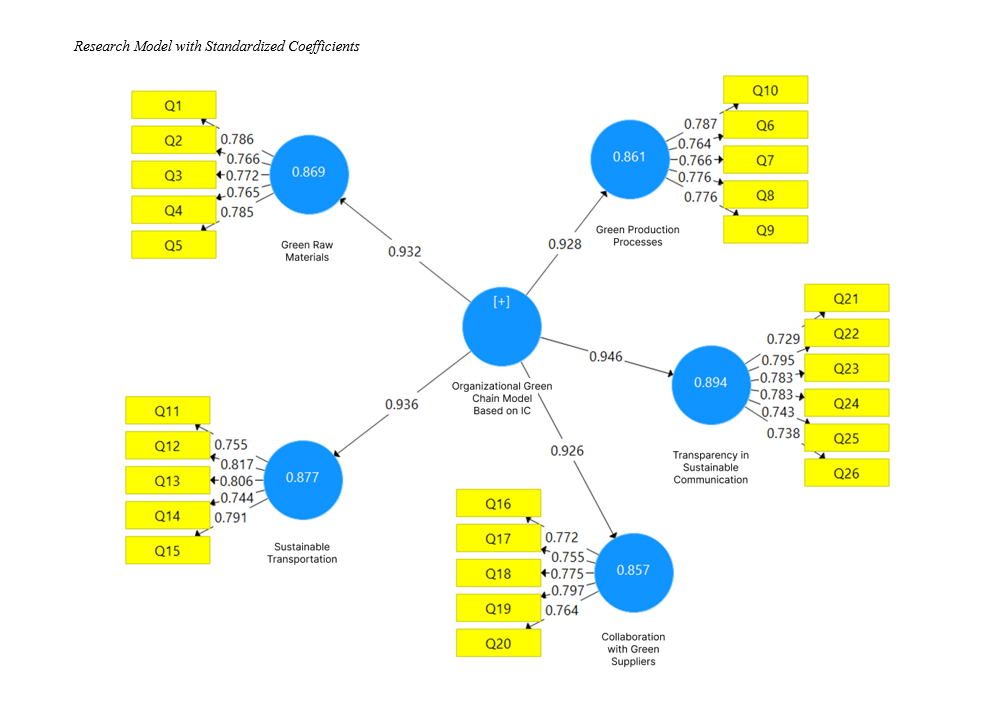Design and Evaluation of the Organizational Green Chain Model Based on Intellectual Capital in Iraq’s Textile Industry
Keywords:
green logistics, green chain, green intellectual capital, environment, textile industryAbstract
The aim of the present study is to design and evaluate an organizational green chain model based on intellectual capital in the textile industry of Iraq. This research is exploratory-applied in terms of its objective and descriptive-survey in terms of methodology. The research design follows a mixed-methods approach, combining both qualitative and quantitative methods. The statistical population in the qualitative section includes experts and managers in Iraq's textile industry as well as university professors. A total of 10 individuals were selected for interviews using a combination of snowball and random sampling methods. In the quantitative section, the statistical population includes employees in Iraq’s textile industry. The population is considered unlimited; based on Cochran’s formula, a sample size of 384 participants was determined. The data analysis tool in the qualitative section is thematic analysis, while in the quantitative section it is structural equation modeling using PLS software. The qualitative findings reveal that five main dimensions, along with their components, were extracted from expert interviews. These dimensions include green raw materials, green production processes, sustainable transportation, collaboration with green suppliers, and transparency in sustainable communication. In the quantitative section, the overall model fit, based on the GOF formula, was calculated at 67%, indicating a strong model fit. Additionally, the factor loadings in both first- and second-order constructs were greater than 0.40, confirming the validity of the confirmatory factor analysis.
References
Abbas, H., & Tong, S. (2023). Green Supply Chain Management Practices of Firms with Competitive Strategic Alliances-A Study of the Automobile Industry. Sustainability, 15(3), 2156. https://doi.org/10.3390/su15032156
Ali, S. R., Hossain, M. A., Islam, K. Z., & Alam, S. S. (2024). Weaving a greener future: The impact of green human resources management and green supply chain management on sustainable performance in Bangladesh's textile industry. Cleaner Logistics and Supply Chain, 10, 100143. https://doi.org/10.1016/j.clscn.2024.100143
Amores-Salvado, J., Cruz-Gonzalez, J., Delgado-Verde, M., & Gonzalez-Masip, J. (2021). Green technological distance and environmental strategies: the moderating role of green structural capital. J. Intellect. Cap., 22(5), 938-963. https://doi.org/10.1108/JIC-06-2020-0217
Brandenburg, M., Govindan, K., Sarkis, J., & Seuring, S. (2014). Quantitative Models for Sustainable Supply Chain Management: Developments and Directions. Eur. J. Oper. Res.VL - 233, 299-312. https://doi.org/10.1016/j.ejor.2013.09.032
Chang, C. H., & Chen, Y. S. (2012). The determinants of green intellectual capital. Manag. Decis., 50(1), 74-94.
Dzhengiz, T., & Niesten, E. (2020). Competences for environmental sustainability: a systematic review on the impact of absorptive capacity and capabilities. J. Bus. Ethics, 162(4), 881-906. https://doi.org/10.1007/s10551-019-04360-z
Famiyeh, S., Adaku, E., Amoako-Gyampah, K., Asante-Darko, D., & Amoatey, C. T. (2018). Environmental management practices, operational competitiveness and environmental performance: empirical evidence from a developing country. J. Manuf. Technol. Manag., 29(3), 588-607. https://doi.org/10.1108/JMTM-06-2017-0124
Gonzalez, V., Agrawal, D., Johansen, R., & Hooker, R. (2022). Green supply chain practices: The role of institutional pressure, market orientation, and managerial commitment. Cleaner Logistics and Supply Chain, 5, 100067. https://doi.org/10.1016/j.clscn.2022.100067
Jihu, L. (2024). Green Supply Chain Management Optimization Based on Chemical Industrial Clusters.
Judijanto, L., Utami, E. Y., & Harsono, I. (2024). Green Supply Chain Finance: A Bibliometric Review of Financing Instruments, Challenges, and Opportunities. West Science Interdisciplinary Studies, 2(03), 647-655. https://doi.org/10.58812/wsis.v2i03.745
Jum'a, l., ikram, M., alkalha, Z., & alaraj, M. (2022). Factors affecting managers' intention to adopt green supply chain management practices: evidence from manufacturing firms in Jordan. Environmental science and pollution research international, 29(4), 5605-5621. https://doi.org/10.1007/s11356-021-16022-7
Kianto, J., Saenz, N., & Aramburu, N. (2017). Knowledge-based human resource management practices, intellectual capital and innovation. J. Bus. Res., 81, 11-20. https://doi.org/10.1016/j.jbusres.2017.07.018
Motiei, A. M., Khani, M., & Bayrami, S. (2020). The effect of green time chain and human resources management on environmental performance: the mediating role of green innovation. Andisheh Amad Scientific Journal, 77(20), 165-196.
Pal, B., Sarkar, A., & Sarkar, B. (2023). Optimal decisions in a dual-channel competitive green supply chain management under promotional effort. Expert Systems with Applications, 211, 118315. https://doi.org/10.1016/j.eswa.2022.118315
Van Vo, H., & Nguyen, N. P. (2023). Greening the Vietnamese supply chain: The influence of green logistics knowledge and intellectual capital. Heliyon, 9(5). https://doi.org/10.1016/j.heliyon.2023.e15953
Yu, Z., Quudoos, M. U., Akhtar, M. H., Amin, M. S., Razzak, L., Tariq, M., & Khan, S. A. R. (2020). Re-examining the nexuses of communicable diseases, environmental performance, and dynamics of sustainable development in OECD countries. Environmental Science and Pollution Research, 29IS - 6, 1170-1181.
Zheng, G., Haq, M. Z. U., Huo, B., Zhang, Y., & Yue, X. (2024). Leveraging intellectual capital for building a supply chain circular economy system: A knowledge-based view. International Journal of Production Economics, 272, 109225. https://doi.org/10.1016/j.ijpe.2024.109225

Downloads
Published
Submitted
Revised
Accepted
Issue
Section
License
Copyright (c) 2024 Hasanain Ahmed Abd Ali Alfayyadh (Author); Sayyed Hamidreza Mirtavousi; Tariq Kadhim Shlaka , Saeid Aghasi (Author)

This work is licensed under a Creative Commons Attribution-NonCommercial 4.0 International License.









